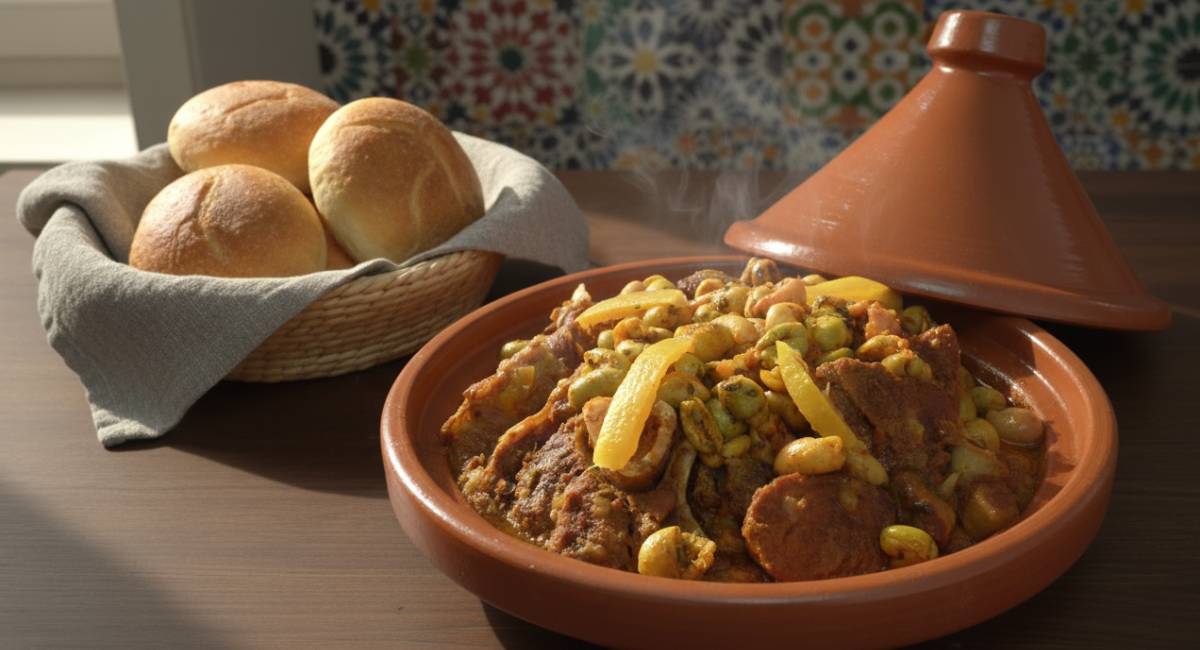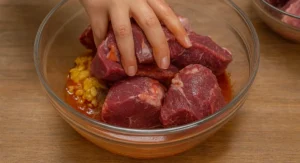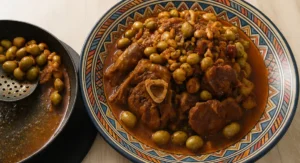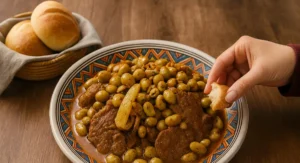
Table of Contents
My Marrakech Memory: Tagine, Taxi, and Amina’s Welcome
Moroccan beef tagine. That’s what I crave when the day is long, the road behind me, Marrakech dust in my hair. I step out of my cab at the old taxi station. The air… thick with stories, horn calls, the smell of hot metal and cumin drifting on the breeze.

There’s Amina’s place. She’s standing at her doorway — that old, generous smile. “Ah, the Rbatti comes back after too long,” she teases, apron wrapped, hands strong but gentle. I walk in. The clay pot is already warming, and I know what’s inside.
It’s home. It’s memory. My voice is small, but hungry. “Amina — the tagine with preserved lemons and olives, please. Just like you always make it, no potatoes.”
She nods, proud and steady. “For you, Si Khalid, always as you like. Some want it rich with potatoes, but you, you want it honest: beef, onions, lemons, olives. Simple and true.”
I stand by, steam fogging my glasses, mouth watering. She moves with rhythm, stories pouring out as she lifts the lid. Tradition isn’t written here — it’s spoken, shown, shared. Every bite will remind me: I’m never just a customer. I’m a welcome guest, bathed in the warmth of Amina’s kitchen.
“Tagine is not just a dish you eat,” I hear Amina say,
“It’s a moment you share. The road might be hard, but there’s always a table waiting.”
The Flavors That Bring Us Together—Why Preserved Lemons and Olives Matter
Moroccan beef tagine needs its heart — preserved lemons and green olives.
When the clay pot opens, you smell beef and onions first. But it’s that sharp, salty-sour scent from lemons that hits deepest—olives too — shining, briny, alive. The sauce wakes up, the bread wants dipping.
Some cook tagine with potatoes, carrots, maybe prunes or apricots. That’s good, but not today. Today, it’s the sourness, that old taste — lemons packed in salt, months of patience. Green olives, you bite and feel the sun, the groves, the bitter earth.
Amina always said:
“If you cook tagine without preserved lemons or good olives, it’s warm—but not Moroccan. The real magic is what your grandmother put aside months ago, planning a good meal in a simple pot.”
I stir with a wooden spoon, watching the color change.
The meat softens, the lemon melts, and the olives flavor every drop.
You taste old days, family laughter, stories from the kitchen.
This is why we gather around the tagine and eat together.
Essentials: Ingredients for Authentic Moroccan Beef Tagine
Moroccan beef tagine. You don’t start with the pot. You start with what goes inside. The smell, the touch — picking the right piece, listening to years of advice, remembering what works.
You lay everything out on your old wooden board. Some days the ingredients look simple, but the way you handle them… that’s what makes the tagine honest.
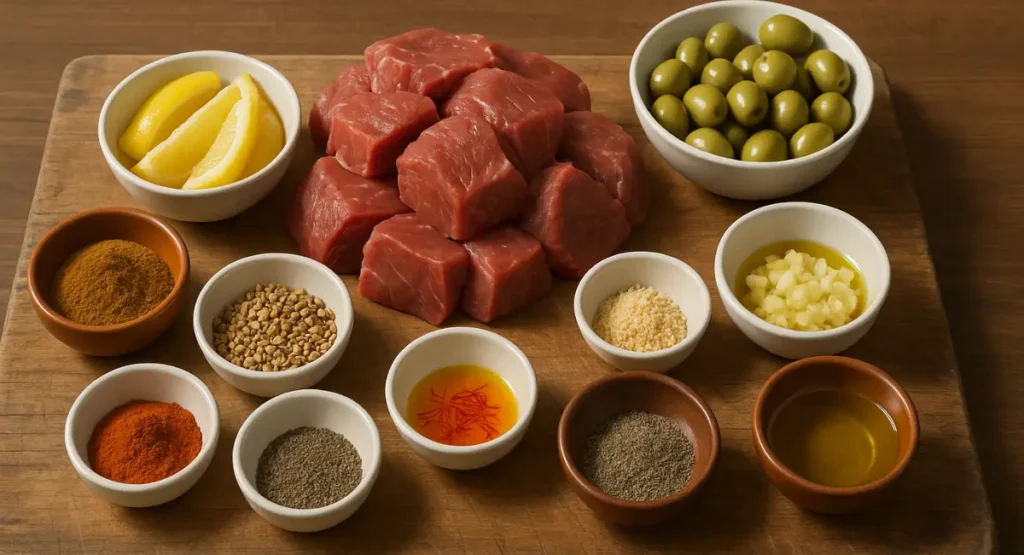
Choosing Your Beef: Cuts That Work
You want beef with muscle. Not the fancy steak — something with work in it.
- Chuck
- Shank
- Shoulder
You press the meat — a little fat, some toughness. That’s what will melt after hours.
Sometimes I choose lamb, but for this, it’s beef, like you’d find at the old market in Rabat.
You cut it into chunks — not too small. Let the meat keep its shape, let it fall apart when the time is right.
“Good tagine comes from good beef, patience, and a lid that stays closed.”
That’s what my uncle used to say when I watched him by the stove.
The Spice Blend: Saffron, Cumin, and Stories
You need spices that tell a story.
- Saffron threads, barely a pinch, bloomed in warm water — makes the color deep
- Cumin, ground fine — earthy, almost smoky
- Coriander seeds, pounded, not just dust
- Paprika for sweet
- Black pepper for fire
- Garlic for bite
You smell the mix in your palm, close your eyes for a second. Some days the blend is strong, other days gentle.
Sometimes, smen — that Moroccan aged butter — gives everything a bold kick. If you don’t have it, use a good olive oil, trust your hands.
Spices are memory.
Someone spent years learning how much to add, when to stir. I know by scent, by watching the steam.
Preserved Lemons & Green Olives: The Heart of the Pot
This is the soul.
- Preserved lemons, sliced thin, full of salt and time
- Green olives — firm, bitter, promise of the sun
Don’t rush these.
Lemons go in the sauce, sometimes in the marinade. Olives, in their own pan, are cooked down until the sauce clings.
Without both, you lose the taste that brings everyone to the table.
“A tagine with no lemons or olives is like a story missing its old punchline,”
Amina would say, laughing, spoon in her hand.
You gather the ingredients, slow and careful, like setting a table for old friends.
Step-by-Step Cooking: The Artisan’s Process
Moroccan beef tagine. Don’t rush. The kitchen is quiet. Steam rises, herbs scatter on the countertop. You cook slow, you trust your hands, you let the day pass.
Preparing the Marinade and Meat

The beef sits in a bowl. Big pieces, not too neat.
Marinade essentials :
- Crushed garlic
- Cumin
- Coriander
- Paprika
- Salt
- Olive oil
- Sliver of preserved lemon
- Saffron water
Pour some olive oil. Sometimes, it stings the nose, making everything taste like old Morocco.
In goes a sliver of preserved lemon—bright, sharp. Saffron water, golden and smooth.
Mix it all. Hands, not a spoon.
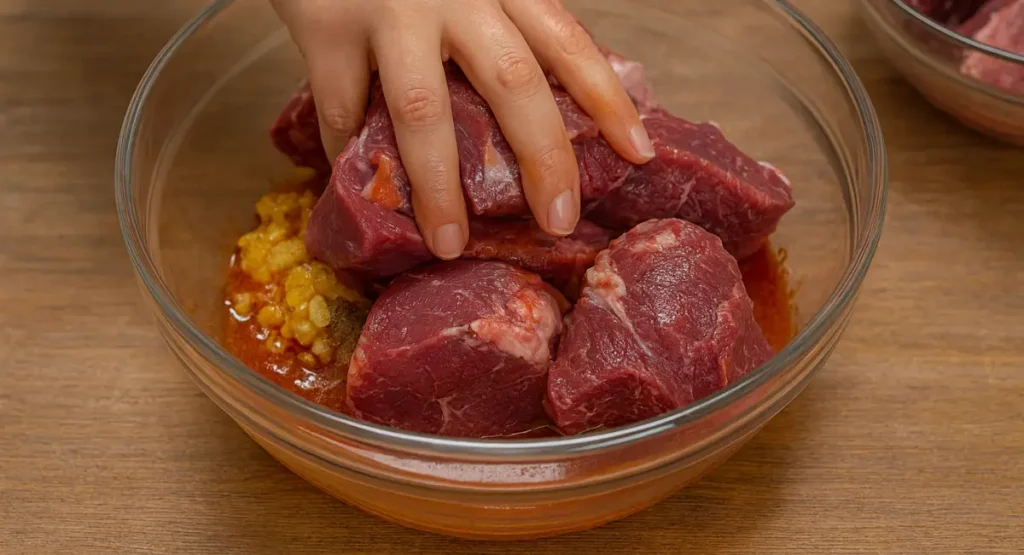
Touch every piece. Get the spice deep, under the fat, into the bone.
Cover it. Let it sit. One hour, maybe two.
Cold air or warm, it doesn’t matter. The beef is working, soaking up the sun and salt.
“Marinade is where the story begins,”
My father used to whisper, watching the pot heat up.
Searing and Simmering: Hand vs. Clay Pot
The pot waits.
You drop in the beef. It sizzles, talks back, and releases a sweet onion scent.
Brown it just a little. Not more.

Add to the pot:
- Chopped onion
- Leftover marinade
- A touch more oil
- A bit of water (if stew is too thick)
A clay pot is best. Lid heavy, steam trapped, flavors dance.
But I’ve used a Dutch oven, old iron — good enough if you go slow.
You turn the heat down. Let the quiet cover everything. Meat softens, onions fade, sauce grows thick.
“Don’t lift the lid too soon,”
Amina warned me.
“Tagine needs patience, not curiosity.”
Building the Olive Sauce
While the beef simmers, you get the olives ready.
Ingredients for olive sauce:
- Green olives (rinsed, pitted if preferred)
- Lemon juice
- Parsley
- Garlic
- Cumin
- Coriander
- Paprika
- A pinch of chili (optional)
- Preserved lemon
- Olive oil
- Water
Let it boil, then turn it down.
Olives bubble, and the sauce grabs onto them.
Stir. Taste. It should be salty, slightly sour, and thick enough to coat the back of your spoon.
Bringing It All Together: Final Assembly
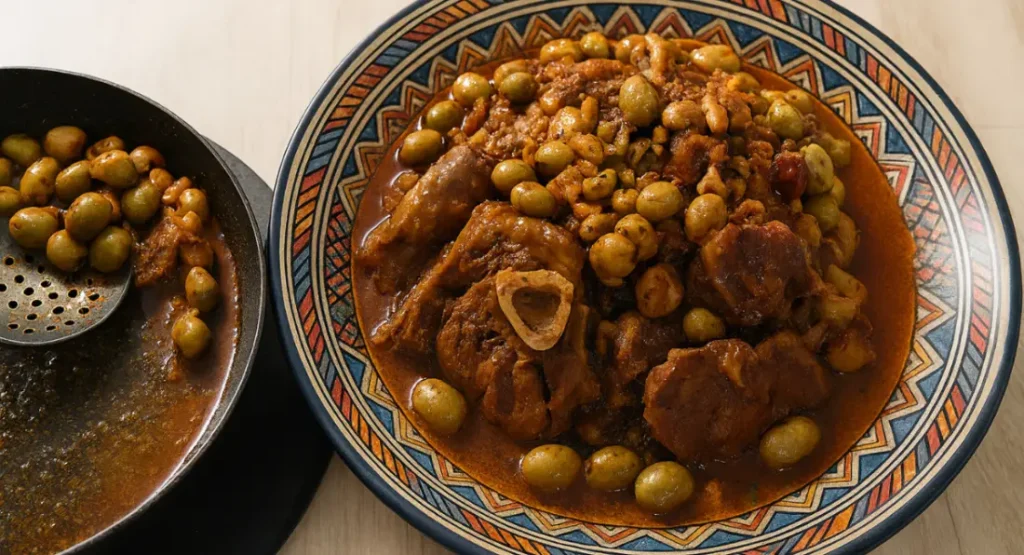
The kitchen smells old — like Friday, like friends, like bread coming soon.
Beef is ready. Sauce is deep, and onions have almost vanished.
To serve:
- Move the meat to a big dish
- Pour over the thick sauce
- Spoon olives all around
- Sprinkle fresh parsley (optional)
- Serve with crusty bread
You feel a little tired, a lot hungry, and completely at home.
“Food tastes better when you remember who made it.”
That’s what I believe, every time I cook.
Serving Tradition: Bread, Table, and Family
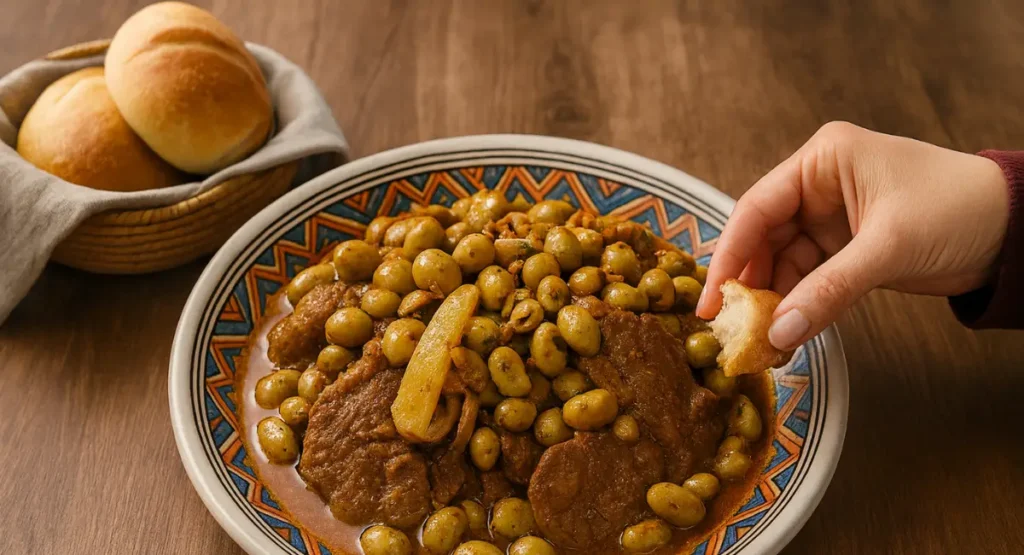
Moroccan beef tagine. The pot is ready, steam lifting — that’s just the start. The real meal happens when the family gathers, the table fills, and bread breaks.
Windows open, voices mix. The tagine sits in the middle, hot and proud. No plates at first. Just hands, just bread, just people.
How to Serve Tagine Like We Do at Home
- Put the tagine in the center, right on the table.
- Khobz — round, crusty Moroccan bread — stacked beside.
- You tear your bread, not slice.
- Everyone reaches in. Nobody waits for a signal.
- The meat goes first, onions and sauce cling.
- Olives scattered around, maybe some fresh parsley for color.
- Hot. Steaming. Fragrant.
“The best bite is the one someone hands you,”
My mother smiled once as she passed a chunk to me.
Nobody leaves hungry. The sauce is scooped up, and every last drop vanishes.
Loud laughs, quiet nods, and elbows bumping.
It means you’re home.
Sharing the Sauce—Bread, Olive Oil, Community
- Don’t eat tagine alone.
- It’s a dish for talking, a dish for sharing, a dish for slowing down.
- Bread dips in, comes out dripping.
- Sometimes the olive clings, sometimes just sauce.
- If you want extra shine, pour a little olive oil on top.
- Rich, golden, thick.
- Neighbors drop by, sometimes strangers.
- There’s always enough. You tear off a bigger piece.
- You wipe up what’s left.
“You taste more than food at the table. You taste friendship, patience, what the day brought,”
That’s what I believe.
The table stays busy until nothing is left but smiles.
Tips, Troubleshooting, and Living Wisdom
Moroccan beef tagine. Even after years and miles, you’re always learning. Some days things go sideways, some days the pot sings. Old hands know a few things that save the meal — and save your nerves.
Getting the Salt Just Right
Salt. That’s the trickiest part, I swear.
- Preserved lemons — they’re salty.
- Olives too.
- Smen, that old butter, hides salt in every bite.
- You want to taste before adding more. Always.
- Better to add a little at the end than ruin hours of work with a heavy hand.
“Tagine can forgive many things, but not too much salt,”
Said my grandmother, tasting with the back of her spoon.
- Sometimes I soak the olives in water, just to mellow them out.
- Taste the sauce as it reduces.
- Wait for the lemons to melt.
- Go slow. The salt creeps up on you.
Making It Ahead, Saving the Leftovers
Good news: Moroccan beef tagine gets better the next day.
- The flavors — they meet, settle, get comfortable.
- The beef soaks in the lemons, and the sauce thickens. It’s a gift.
- Let it cool, then pack it in an old container.
- Fridge for up to three or four days, freezer for two months.
- Warm slowly, low heat. No microwave if you can avoid it — it kills what you waited for.
- Taste before serving.
- Maybe a splash of water if it’s thick, a pinch of spice just to wake things up.
Tagine always welcomes you back.
Substitutes and Simplifications for Kitchens
Not in Morocco? No problem.
- Use a Dutch oven or heavy pot instead of a clay tagine.
- No preserved lemons? Zest and juice of a fresh lemon, packed with salt — not the same, but does the job for one meal.
- Olives — choose good green ones, not the canned ones.
- Can’t find smen? Good olive oil is fine.
- Spices — use what you have, but don’t skip cumin or coriander.
“Make it yours. It’s the care, the time, the memory — not the brand of pot,”
Amina would always say.
If you cook with heart, the taste will find its way.
FAQ: Western Adaptations, Storing, Freezing, Common Mistakes
Moroccan beef tagine. I get plenty of questions. Cooks in America — new to the clay pot, curious about old flavors, worried about what’s right and what’s “allowed.” Here’s what I hear the most:
Can I make Moroccan beef tagine without a tagine pot?
Yes. Use a Dutch oven or heavy-bottomed pot.
What matters is slow heat, a closed lid, and lots of patience. Clay has its magic, but any good pot will work if you treat it gently.
What’s the best cut of beef for tagine?
Choose chuck, shoulder, or shank.
You want meat with fat and muscle. The long cook makes it tender — fancy steak dries out.
Leave it chunky. Don’t rush; let the pot do the muscle work.
Can I make preserved lemons at home, or use something else?
You can make them — slice lemons, pack them in salt in a jar for weeks.
In a pinch, use lemon zest and some fresh juice mixed with salt.
It’s not the same, but it gives a little of the old tang.
How do I store and freeze tagine?
Let it cool. Store in airtight containers.
Fridge — three to four days.
Freezer — up to two months.
Reheat on low, add a splash of water if needed.
Microwave? Not if you can help it. Use a pan or a pot.
Why is my tagine too salty or sour?
It could be the preserved lemons, olives, or heavy hand with the salt.
Taste as you cook. Soak olives if they’re very salty.
Add less lemon next time. The sauce should sing, not shout.
Can I add potatoes or prunes like some recipes show?
Yes. Some do — that’s how families change things over the years.
But today I keep it honest: beef, onions, preserved lemon, green olives.
Is it normal for the sauce to be thin or thick? How do I fix it?
It depends — some want it soupy, some want it to coat the bread.
If too thin, open the lid and simmer until it thickens.
If too thick, add a splash of water or broth.
What’s the main mistake cooks make with tagine?
Rushing. Trying to “fix” with too many extras.
Tagine wants time, quiet, and respect for what’s inside.
“Slow food teaches slow living. Don’t hurry a tagine,”
I remind myself every time the kitchen fills with steam.
Passing It On: From Taxi Station to Your Table
Moroccan beef tagine. I learned it on the road, after long hours behind the wheel, shoulders sore, smile ready for the next passenger. The best lessons weren’t written in cookbooks. They came from stopping for a meal with friends, from sharing stories by the stove, from standing in Amina’s kitchen and soaking in her wisdom.
I bring it to you, as it was given to me: a clay pot, a slow cooker, preserved lemons, bitter olives, and tender beef.
Not fancy. Not perfect. Just honest, the way my family did it, the way I tasted it in the noise of Marrakech taxi stands.

If you make Moroccan beef tagine in your kitchen — even without a tagine pot, even if you trade smen for olive oil, even if you use lemons from a jar — you’re passing on more than a recipe. You’re sharing patience, memory, and kindness at the table.
“Eat together.
Cook slowly.
Remember where flavor comes from,”
That’s the silent rule in my kitchen.
Serve your tagine. Invite others. Tell them the story — the long taxi drives, Amina’s generosity, the taste of Morocco in every bite. Let the steam rise and the bread pass from hand to hand.
This is how we keep the tradition alive. One pot, one meal, one story at a time.

Moroccan Beef Tagine with Preserved Lemons and Green Olives
Equipment
- Clay tagine or Dutch oven
- Wooden spoon
- Mixing bowl
- Knife and cutting board
- Small pot (for olive sauce)
- Your hands (for marinating!)
Ingredients
For the meat & marinade:
- 1.75 lbs 800 g beef (chuck, shank, or shoulder), cut into large chunks
- 3 cloves garlic crushed
- 1 tsp ground cumin
- 1 tsp ground coriander
- 1 tsp sweet paprika
- 1/2 tsp black pepper
- 1/2 tsp salt adjust to taste
- 2 tbsp olive oil
- Juice of 1/2 lemon
- 1/4 preserved lemon finely chopped
- A few saffron threads bloomed in 2 tbsp warm water
For cooking:
- 1 large onion chopped
- 1 –2 tbsp olive oil
- 1/3 cup water if needed for simmering
For olive sauce:
- 1 cup green olives rinsed (pitted if preferred)
- 1 tbsp lemon juice
- 2 garlic clove minced
- 1 tsp cumin
- 1 tsp coriander
- 1/2 tsp paprika or chili optional
- 1 tbsp fresh parsley chopped
- 1/4 preserved lemon finely sliced
- 1 tbsp olive oil
- 1/3 cup water
Instructions
- 1. Marinate the beef
- In a bowl, combine beef chunks with garlic, spices, olive oil, preserved lemon, lemon juice, and saffron water.

- Mix thoroughly by hand. Cover and let rest for at least 1 hour.

- 2. Brown the beef
- In a tagine or heavy-bottomed pot, heat a bit of olive oil and lightly sear the beef on all sides. Don’t overbrown — just enough to wake up the flavors.
- 3. Add onions and start simmering
- Add chopped onion, remaining marinade, and a splash of water if needed.

- Cover and simmer over low heat for 2 to 2.5 hours until the meat is tender.
- 4. Make the olive sauce while the beef cooks
- In a small saucepan, combine green olives, preserved lemon, garlic, lemon juice, olive oil, water, and spices.
- Bring to a boil, then lower heat and simmer 15–20 minutes until slightly thickened.
- 5. Assemble and serve
- Transfer beef to a serving dish. Spoon the thick sauce over the meat.
- Add the olive mixture on top or around the dish.

- Garnish with fresh parsley if desired.
- Serve with warm Moroccan bread (khobz).

Notes
- Use your hands to marinate — feel the meat, press the spice in deep.
- Don’t lift the lid too soon — tagine needs patience, not curiosity.
- If the olives are salty, soak them first — taste as you go, not after it’s too late.
🧾 Nutritional Information (Per Serving)
| Nutrient | Amount (Approx.) |
|---|---|
| Calories | 420 kcal |
| Protein | 28 g |
| Total Fat | 25 g |
| – Saturated Fat | 6 g |
| Carbohydrates | 18 g |
| – Sugars | 5 g |
| Fiber | 3 g |
| Sodium | 780 mg |
| Iron | 3.5 mg (20% DV) |
| Vitamin A | 10% DV |
| Vitamin C | 15% DV |
ℹ️ Notes :
These values are approximate, based on ingredients such as chuck beef, olive oil, onions, spices, olives, and tomatoes. If you add prunes, chickpeas, or serve it with bread or couscous, the nutritional values may vary slightly.
📬 Join the Table – Get More Stories, Recipes & Secrets from the Moroccan Kitchen
Do you love recipes that come with stories, not just steps?
Sign up for our newsletter and receive:
✅ Authentic Moroccan recipes with heart and history
✅ Seasonal tips and spice secrets passed down from generations
✅ Free downloads, kitchen guides & tagine how-tos
✅ Early access to our latest articles and recipe drops
This isn’t just a recipe list. It’s a seat at the table.
👉 Enter your email below and let the flavors come to you.
📩 No spam. Just slow food, warm stories, and good company.
📩 Join Our Moroccan Foodie Community
Get the best Moroccan tagine recipes and seasonal culinary tips straight to your inbox.
📱 Follow the Flavor – Let’s Stay Connected!
Love stories like this one? Craving more slow-cooked recipes, Moroccan kitchen secrets, and cultural gems?
Follow us on social media and bring the taste of tradition to your feed:
🔸 Behind-the-scenes cooking moments
🔸 Weekly recipe drops & seasonal inspiration
🔸 Real people, real food, real memories
👉 Follow us now and keep the flavors alive — one post at a time.
💬 Your Turn – Share Your Tagine Story
Have you tried this recipe? Did your kitchen fill with the same warmth and aroma as Amina’s?
Leave a comment below —
🧡 Tell us how it turned out
🧄 Ask a question about the ingredients or process
🌍 Or simply share your own memory of Moroccan food, travel, or tradition
Every comment is welcome — whether it’s your first time cooking a tagine or your grandmother’s version you’re comparing.
Let’s keep the tradition alive, one story at a time.
👇 Start typing — we’re listening.
